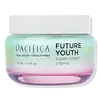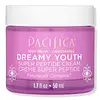What's inside
What's inside
 Key Ingredients
Key Ingredients

 Benefits
Benefits

 Concerns
Concerns

 Ingredients Side-by-side
Ingredients Side-by-side

Water
Skin ConditioningHelianthus Annuus Seed Oil
EmollientGlycerin
HumectantAloe Barbadensis Leaf Juice
Skin ConditioningEthylhexyl Palmitate
EmollientGlyceryl Stearate
EmollientStearic Acid
CleansingGlyceryl Laurate
EmollientSh-Polypeptide-50
Skin ConditioningCaesalpinia Spinosa Gum
Skin ConditioningCaprylic/Capric Triglyceride
MaskingAllantoin
Skin ConditioningPrunus Amygdalus Dulcis Oil
Skin ConditioningSimmondsia Chinensis Seed Oil
EmollientLeuconostoc/Radish Root Ferment Filtrate
AntimicrobialCamellia Japonica Seed Oil
EmollientFragaria Ananassa Seed Oil
AntioxidantPalmitoyl Tripeptide-5
Skin ConditioningPanthenol
Skin ConditioningSaccharomyces/Xylinum/Black Tea Ferment
Skin ConditioningOryza Sativa Extract
AbsorbentPhaseolus Angularis Seed Extract
AntioxidantCitric Acid
BufferingPotassium Sorbate
PreservativeAcetic Acid
BufferingLevulinic Acid
PerfumingMalpighia Glabra Fruit Extract
Skin ConditioningPaeonia Albiflora Root Extract
Skin ConditioningPassiflora Incarnata Flower Extract
Skin ConditioningSodium Levulinate
Skin ConditioningVanilla Planifolia Fruit Extract
Skin ConditioningLeontopodium Alpinum Flower/Leaf Extract
Skin ConditioningAcetyl Hexapeptide-8
HumectantDextran
Caprooyl Tetrapeptide-3
Skin ProtectingMelia Azadirachta Leaf Extract
Skin ConditioningCurcuma Longa Root Extract
MaskingAloe Barbadensis Flower Extract
EmollientCoccinia Indica Fruit Extract
Skin ConditioningCorallina Officinalis Extract
Skin ConditioningMelia Azadirachta Flower Extract
Skin ConditioningOcimum Basilicum Flower/Leaf Extract
TonicOcimum Sanctum Leaf Extract
Skin ConditioningSolanum Melongena Fruit Extract
Skin ConditioningEctoin
Skin ConditioningPhenoxyethanol
PreservativeEthylhexylglycerin
Skin ConditioningTocopherol
AntioxidantMyristyl Nicotinate
Skin ConditioningLimonene
PerfumingLinalool
PerfumingParfum
MaskingWater, Helianthus Annuus Seed Oil, Glycerin, Aloe Barbadensis Leaf Juice, Ethylhexyl Palmitate, Glyceryl Stearate, Stearic Acid, Glyceryl Laurate, Sh-Polypeptide-50, Caesalpinia Spinosa Gum, Caprylic/Capric Triglyceride, Allantoin, Prunus Amygdalus Dulcis Oil, Simmondsia Chinensis Seed Oil, Leuconostoc/Radish Root Ferment Filtrate, Camellia Japonica Seed Oil, Fragaria Ananassa Seed Oil, Palmitoyl Tripeptide-5, Panthenol, Saccharomyces/Xylinum/Black Tea Ferment, Oryza Sativa Extract, Phaseolus Angularis Seed Extract, Citric Acid, Potassium Sorbate, Acetic Acid, Levulinic Acid, Malpighia Glabra Fruit Extract, Paeonia Albiflora Root Extract, Passiflora Incarnata Flower Extract, Sodium Levulinate, Vanilla Planifolia Fruit Extract, Leontopodium Alpinum Flower/Leaf Extract, Acetyl Hexapeptide-8, Dextran, Caprooyl Tetrapeptide-3, Melia Azadirachta Leaf Extract, Curcuma Longa Root Extract, Aloe Barbadensis Flower Extract, Coccinia Indica Fruit Extract, Corallina Officinalis Extract, Melia Azadirachta Flower Extract, Ocimum Basilicum Flower/Leaf Extract, Ocimum Sanctum Leaf Extract, Solanum Melongena Fruit Extract, Ectoin, Phenoxyethanol, Ethylhexylglycerin, Tocopherol, Myristyl Nicotinate, Limonene, Linalool, Parfum
Water
Skin ConditioningHelianthus Annuus Seed Oil
EmollientMyristyl Myristate
EmollientIsopropyl Myristate
EmollientC12-15 Alkyl Benzoate
AntimicrobialButyrospermum Parkii Butter
Skin ConditioningStearic Acid
CleansingGlyceryl Stearate Citrate
EmollientGlycerin
HumectantPalmitoyl Tripeptide-5
Skin ConditioningDipeptide Diaminobutyroyl Benzylamide Diacetate
Skin ConditioningPropanediol
SolventGlyceryl Stearate
EmollientSodium Stearoyl Glutamate
CleansingCetyl Alcohol
EmollientStearyl Alcohol
EmollientBetaine
HumectantArginine
MaskingSodium PCA
HumectantHibiscus Sabdariffa Flower Extract
Skin ConditioningIris Pallida Leaf Cell Extract
AntioxidantRosa Damascena Flower Water
MaskingPelargonium Graveolens Oil
MaskingDibutyl Lauroyl Glutamide
Skin ConditioningTocopheryl Acetate
AntioxidantXanthan Gum
EmulsifyingPhenoxyethanol
PreservativeEthylhexylglycerin
Skin ConditioningWater, Helianthus Annuus Seed Oil, Myristyl Myristate, Isopropyl Myristate, C12-15 Alkyl Benzoate, Butyrospermum Parkii Butter, Stearic Acid, Glyceryl Stearate Citrate, Glycerin, Palmitoyl Tripeptide-5, Dipeptide Diaminobutyroyl Benzylamide Diacetate, Propanediol, Glyceryl Stearate, Sodium Stearoyl Glutamate, Cetyl Alcohol, Stearyl Alcohol, Betaine, Arginine, Sodium PCA, Hibiscus Sabdariffa Flower Extract, Iris Pallida Leaf Cell Extract, Rosa Damascena Flower Water, Pelargonium Graveolens Oil, Dibutyl Lauroyl Glutamide, Tocopheryl Acetate, Xanthan Gum, Phenoxyethanol, Ethylhexylglycerin
 Reviews
Reviews

Ingredients Explained
These ingredients are found in both products.
Ingredients higher up in an ingredient list are typically present in a larger amount.
Ethylhexylglycerin (we can't pronounce this either) is commonly used as a preservative and skin softener. It is derived from glyceryl.
You might see Ethylhexylglycerin often paired with other preservatives such as phenoxyethanol. Ethylhexylglycerin has been found to increase the effectiveness of these other preservatives.
Glycerin is already naturally found in your skin. It helps moisturize and protect your skin.
A study from 2016 found glycerin to be more effective as a humectant than AHAs and hyaluronic acid.
As a humectant, it helps the skin stay hydrated by pulling moisture to your skin. The low molecular weight of glycerin allows it to pull moisture into the deeper layers of your skin.
Hydrated skin improves your skin barrier; Your skin barrier helps protect against irritants and bacteria.
Glycerin has also been found to have antimicrobial and antiviral properties. Due to these properties, glycerin is often used in wound and burn treatments.
In cosmetics, glycerin is usually derived from plants such as soybean or palm. However, it can also be sourced from animals, such as tallow or animal fat.
This ingredient is organic, colorless, odorless, and non-toxic.
Glycerin is the name for this ingredient in American English. British English uses Glycerol/Glycerine.
Learn more about GlycerinGlyceryl Stearate is a mix of glycerin and stearic acid.
It is used to stabilize the mixing of water and oil ingredients. By preventing these ingredients from separating, it can help elongate shelf life. It can also help thicken the product's texture.
As an emollient, it helps soften skin and supports barrier-replenishing ingredients.
In cosmetics, Glyceryl Stearate is often made from vegetable oils or synthetically produced.
This ingredient may not be fungal-acne safe
Fun fact: The human body also creates Glyceryl Stearate naturally.
Learn more about Glyceryl StearateHelianthus Annuus Seed Oil is the oil derived from the seeds of a Sunflower. Sunflower seed oil is non-fragrant. It is an emollient, meaning it helps to soften the skin.
Sunflower seed oil contains many fatty acids. The fatty acids found in sunflower seeds include (from highest amount to least): linoleic acid, myristic acid, palmitic acid, stearic acid, arachidic acid, oleic acid, and linolenic acid.
These fatty acids help the skin create ceramides. Ceramides play a role in repairing the skin barrier.
Helianthus Annuus Seed Oil helps moisturize the skin. This in turn helps the skin look more rejuvenated and smoother.
Sunflowers are rich in vitamin E.
Historians believe Indigenous cultures of North America domesticated sunflowers before corn. Thus they relied on sunflower oil for a variety of uses. One such use is moisturizing skin and hair.
Sunflower seed oil may not be fungal acne safe. We recommend speaking with a professional if you have any concerns.
Learn more about Helianthus Annuus Seed OilThis synthetic peptide is created from lysine, valine, and palmitic acid.
According to the manufacturer, in-vitro studies show tissue growth and collagen synthesis. Another in-vivo study found 60 volunteers saw a significant reduction in wrinkles after 84 days.
Due to its palmitic acid base, this peptide may not be fungal-acne safe.
Learn more about Palmitoyl Tripeptide-5Phenoxyethanol is a preservative that has germicide, antimicrobial, and aromatic properties. Studies show that phenoxyethanol can prevent microbial growth. By itself, it has a scent that is similar to that of a rose.
It's often used in formulations along with Caprylyl Glycol to preserve the shelf life of products.
Stearic Acid is a fatty acid. It is an emollient, emulsifier, and texture enhancer.
As an emollient, stearic acid helps soften skin. It aids the skin's protective barrier by preventing water loss. It also provides a gentle cleansing effect without stripping away natural oils.
Stearic acid may also be used to enhance the texture of products. It can add volume and stabilize ingredients such as water and oil. This can help water and oil ingredients from separating.
Sources of stearic acid include animal or vegetable fats/oils such as coconut or shea. It can be naturally found in butter, cocoa butter, shea butter, vegetable fats, and animal tallow.
This ingredient may not be Malassezia folliculitis, or fungal-acne safe.
Learn more about Stearic AcidWater. It's the most common cosmetic ingredient of all. You'll usually see it at the top of ingredient lists, meaning that it makes up the largest part of the product.
So why is it so popular? Water most often acts as a solvent - this means that it helps dissolve other ingredients into the formulation.
You'll also recognize water as that liquid we all need to stay alive. If you see this, drink a glass of water. Stay hydrated!
Learn more about Water